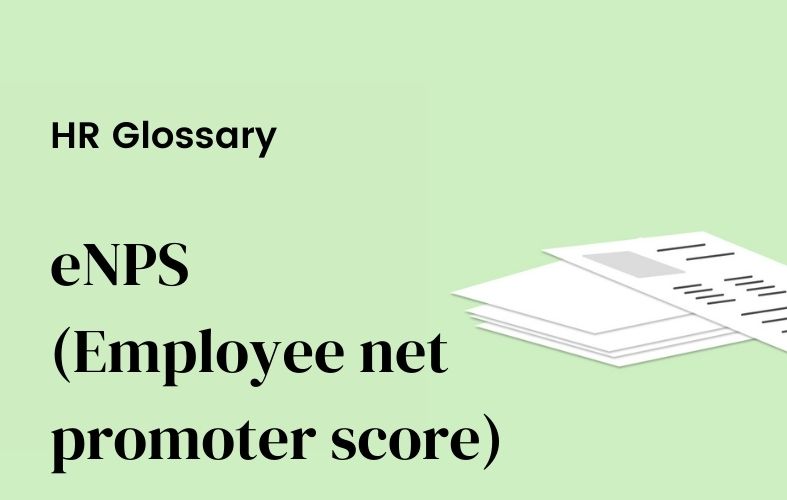Employee net promoter score (eNPS)

[Sommaire]
What is the employee net promoter score?
The employee net promoter score, normally abbreviated to eNPS, to measure employee engagement.
It tells you how likely your employees are to recommend your organization as a place to work. The idea originates from how to measure customer loyalty - net promoter score (NPS).
How do you calculate the employee net promoter score?
To calculate your organization’s eNPS, you must survey your employees and then run a simple calculation.
1. Ask employees how likely they are to recommend your organization as a place to work on a scale of 1-10. 1 is the lowest likelihood, 10 is highly likely.
2. Depending on their responses, you then group employees into one of three segments – promoters, neutrals and distractors.
- Employees who score either 9 or 10 are ‘promoters’.
- Employees who score 7 or 8 are ‘neutrals’.
- Employees who score between 1 and 6 are ‘distractors’.
3. To determine your eNPS, you must calculate the percentage of distractors and promoters within your survey results. You then subtract the percentage of distractors from the percentage of promoters. This gives you your eNPS score.
% promoters - % distractors = eNPS
Here’s an example :
You have 100 employees. 8 employees classify as promoters (8%), and 33 of them classify as distractors (33%). By subtracting the number of promoters from the number of distractors, you get a disappointing score eNPS of -25.
The best score you could get is 100 (all employees are promoters, none are distractors or neutrals). The worst score is -100 (all employees are distractors, none are promoters or neutral). Any score above zero is thought to be good.
Why is an employee net promoter score important in a company?
The employee net promoter score is important because it provides a simple measure of employee satisfaction and helps to avoid high employee turnover. Even more importantly, Gallup found that a high eNPS is strongly linked to employee engagement. And as it is strongly linked to business success, that is an important correlation.
A study by the Harvard Business Review found that companies with engaged employees outperform their competitors by 2.6 times. Employee experience is also linked to lower staff turnover rates, less need for replacements and associated training costs, and higher customer satisfaction scores.
How to structure your eNPS cycles?
1. Employee Net Promoter Scores should be measured at least annually
2. The eNPS question ("How likely are you to recommend our company as a great place to work?") should be asked anonymously and in writing (eg. via an online employee engagement surveys tool)
3. The responses to the eNPS surveys should be used to measure employee loyalty
4. The company's Employee Net Promoter Score should be shared with all employees
5. Employee feedback should be gathered to understand the reasons behind the score
6. Ideas for improvements should be generated based on the feedback received
7. Improvements should be implemented and monitored
8. The cycle should be repeated on a regular basis to ensure that employee loyalty remains high
How do you improve your employee net promoter score?
Many factors go into making a company a great place to work, but employee engagement is undoubtedly one of the most important. And the eNPS is one of the best ways to measure and track this engagement levels over time.
To improve your employee net promoter score, there are several steps you can take. These include :
1. Following up your eNPS pulse
Following up your eNPS pulse with a survey to understand why employees might have given the scores they gave.
If you are able to segment your eNPS data by demographic group, business function or seniority and then segment the responses of your follow-up survey, you may find greater insight to act upon.
2. Share your learnings
With employees to explain what you have learned.
This type of transparency will demonstrate that you are committed to improving things and want to get their input. This can help improve trust and start to engage your employees in evolving your company culture.
3. Track your eNPS score over time
By tracking the movement of your eNPS, you can get an insight into the current engagement scores in your company.
You can use it to track the success of new initiatives, understand how increased workload is affecting employees, and understand if there are any hidden problems at play that you need to investigate.
4. Use your eNPS data to improve your company culture
By making changes based on the feedback you’ve received, you can start to improve your company culture.
As employee experience and engagement is linked to business success, this can have a positive knock-on effect on your business as a whole.
Which questions to include in your eNPS survey?
The eNPS question is simple: “How likely are you to recommend our company as a place to work to your friends and family?”
However, there are other questions you can ask to get further insight into the engagement of employees. These include:
- “What is the main reason you would not recommend our company as a place to work?”
- “What is the main reason you would recommend our company as a place to work?”
- “How engaged are you with your work?”
- “Do you feel like your work is meaningful and has a purpose?”
By asking these questions, you can start to get a more detailed picture of employees' feel and engagement in your company. You can use this data to improve your eNPS score and, as a result, your business's bottom line.
To sum up
The eNPS is a valuable tool for measuring employee engagement, but it is only one part of the puzzle. Employee feedback should also be gathered to understand the reasons behind the score, and ideas for improvements should be generated based on this feedback. Improvements should then be implemented and monitored to ensure that it remains high.


